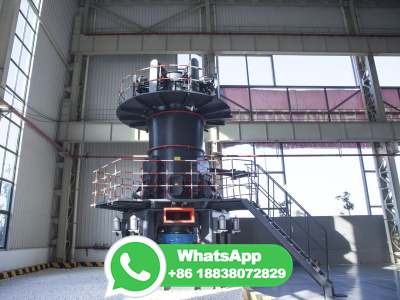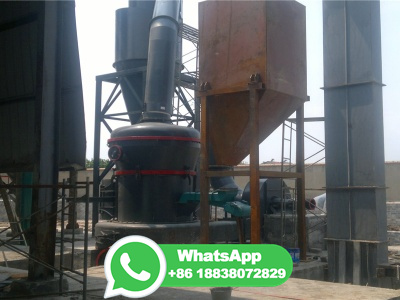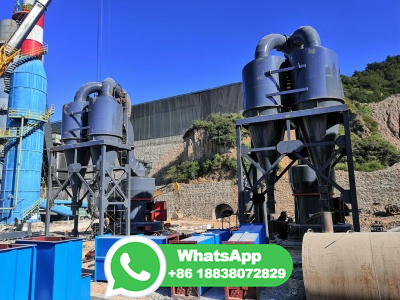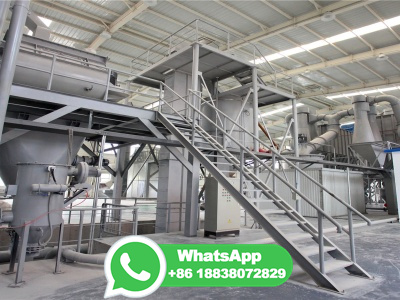
Coal gasification is one of the more waterintensive forms of energy production, and large areas of China, particularly in the western parts of the country that would host new gasification...
WhatsApp: +86 18203695377
In industrial chemistry, coal gasification is the process of producing syngas —a mixture consisting primarily of carbon monoxide (CO), hydrogen ( H2 ), carbon dioxide ( CO2 ), methane ( CH4 ), and water vapour ( H2O )—from coal and water, air and/or oxygen. Historically, coal was gasified to produce coal gas, also known as "town gas".
WhatsApp: +86 18203695377
The Shell Coal Gasification Process for. Reliable Chemicals, Power, and Liquids Production Rob van den Berg, ZhongXin Chen, Shell (China) Projects Technology Ltd ... the gasification process is the gasifier, a vessel in which the feedstock(s) reacts with air or oxygen at high temperatures. The CO:H
WhatsApp: +86 18203695377
Table 1. Comparison of different processes for natural gas production. As to the prevailed twosteps method, the first step is to convert coal to synthesis gas, and the second step is to use a methanation way for the natural gas synthesis.
WhatsApp: +86 18203695377
What is gasification? We can understand gasification by first understanding combustion. Combustion, or burning, is the complete oxidation of a fuel such as coal, a process that produces heat and ...
WhatsApp: +86 18203695377
Gasification is a partial oxidation process. The term partial oxidation is a relative term which simply means that less oxygen is used in gasification than would be required for combustion (, burning or complete oxidation) of the same amount of fuel. Gasification typically uses only 25 to 40 percent of the theoretical oxidant (either pure oxygen or air) to generate enough heat to gasify ...
WhatsApp: +86 18203695377
How Gasification Works Loading... What is coal gasification? Learn what coal gasification is in this article.
WhatsApp: +86 18203695377
Technologies for hydrogen (H2) production fall into four main categories: Thermal Processes: Thermal processes use the energy in various feedstocks (natural gas, coal, biomass, etc.) to release the H2 that is part of their molecular structure. The main hydrogen production technologies using fossil fuels are all thermal processes, and include reforming, gasification, and pyrolysis.
WhatsApp: +86 18203695377
1. Introduction. Gasification technology offers one of the cleanest ways for different carbonaceous feedstocks. Since the 21st century, the C1 chemical industry based on syngas has developed rapidly under the promotion of largescale coal gasification technology, especially in a country rich in coal resources. 1 With the development of gasification technology, the feedstock of gasifiers ...
WhatsApp: +86 18203695377
Coal combustion and gasification are the processes to utilize coal for production of electricity and many other applications. Global energy demand is increasing day by day. Coal is an abundant source of energy but not a reliable source as it results into high CO2 emissions. Energy industries are expected to decrease the CO2 emission to prevent global warming. Coal gasification is a process ...
WhatsApp: +86 18203695377
Gasification One means of converting coal to an alternate form of energy is gasification. In this process, coal is combined with oxygen and steam to produce a combustible gas, waste gases, char, and ash. The more than 70 coal gasification systems available or being developed in 1979 can be classified by
WhatsApp: +86 18203695377
Gasification One means of converting coal to an alternate form of energy is gasification. In this process, coal is combined with oxygen and steam to produce a combustible gas, waste gases, char, and ash. The more than 70 coal gasification systems available or being developed in 1979 can be classified by
WhatsApp: +86 18203695377
The process is known as gasification, a set of chemical reactions that uses limited oxygen to convert a carboncontaining feedstock into a synthetic gas, or syngas. Advertisement. It sounds like combustion, but it's not. Combustion uses an abundance of oxygen to produce heat and light by burning. ... Biomass gasification works just like coal ...
WhatsApp: +86 18203695377
Theoretical Bases of Coal Gasification. Krichko(General Rapporteur), in Oils and Gases from Coal, 1980 1 The Lurgi Process. The Lurgi process is the gasification method most widely employed in industry. It is used to produce town and industrial gas in Australia, Czechoslovakia, the German Democratic Republic, the Federal Republic of Germany, South Africa, the United Kingdom and other ...
WhatsApp: +86 18203695377
With the help of Aspen Plus, the ninth paper developed a twodimensional unsteady CFD model to simulate the coal gasification process in a fixed bed gasifier. A developed and validated two dimensional CFD model for coal gasification has been used to predict and assess the viability of the syngas generation from coal gasification employing the ...
WhatsApp: +86 18203695377
Coal gasification is recognized as the core technology of clean coal utilization that exhibits significant advantages in hydrogenrich syngas production and CO2 emission reduction. This review briefly discusses the recent research progress on various coal gasification techniques, including conventional coal gasification (fixed bed, fluidized bed, and entrained bed gasification) and relatively ...
WhatsApp: +86 18203695377
coal gasification, any process of converting coal into gas for use in illuminating and heating. The first illuminating gas was manufactured from coal in England in the late 18th century by the process of carbonization or destructive distillation, heating coal in the absence of air, leaving a residue of coke as a byproduct.
WhatsApp: +86 18203695377
Coal gasification is the process of producing syngascontaining carbon monoxide, carbon dioxide, natural gas, and hydrogen from coal. This method of generating hydrogen, classified as brown/black, places the largest strain on the environment. The main use of syngas is to produce power by combustion.
WhatsApp: +86 18203695377
1. Gasification is a technological process that can convert any carbonbased raw material such as coal, biomass and organic wastes into fuel gas, also known as syngas (netl, 2021). Gasification typically takes place in a high temperature pressure vessel where oxygen (or air)
WhatsApp: +86 18203695377
During coal gasification, coal is reacted with oxygen, steam and carbon dioxide to form a gas containing hydrogen and carbon monoxide. During this process, which is essentially incomplete combustion, the heat evolved is consumed and the sulfur and nitrogen in the coal are converted to hydrogen sulfide (rather than sulfur
WhatsApp: +86 18203695377
The figure of gasification reactions and transformations illustrated the concept of coal gasification, and noted resulting composition of syngas. This can vary significantly depending on the feedstock and the gasification process involved; however typically syngas is 30 to 60% carbon monoxide (CO), 25 to 30% hydrogen (H 2), 0 to 5% methane (CH 4), 5 to 15% carbon dioxide (CO 2), plus a lesser ...
WhatsApp: +86 18203695377
During gasification, the coal is blown through with oxygen and steam (water vapor) while also being heated (and in some cases pressurized). If the coal is heated by external heat sources the process is called "allothermal", while "autothermal" process assumes heating of the coal via exothermal chemical reactions occurring inside the gasifier ...
WhatsApp: +86 18203695377
In the Shell gasification process, coal is crushed and dried and then fed into the Shell gasifier as a dry feed. The gasifier, as shown in Fig. 36, is an oxygenblown, waterwall gasifier eliminating refractory durability issues. It is good for a wide variety of feedstocks, from pet coke to lowrank coals, and has been run on biomass as well.
WhatsApp: +86 18203695377
In the coal gasification process, temperature has been proven as the most crucial parameter to maintain syngas consistency in the product gas stream. The gasification temperature influences the chemical reactions (, R1R10) occurring in different zones of the gasifier. Therefore, both the quality and the concentration of gaseous species ...
WhatsApp: +86 18203695377
1. Introduction. Coal gasification is a process in which coal reacts with gasification agents (, steam, O 2 /air, and CO 2) at a certain temperature and pressure to produce clean synthesis gas, which can be used as gaseous fuel or as a raw material for chemical synthesis to produce various chemical products and liquid gasification is an important way to achieve the clean and ...
WhatsApp: +86 18203695377
The entrainedbed coal gasification process is the cleanest and most efficient coal gasification technology (Fan 2013; Liu et al. 2010; Wang 2014). At present, the entrainedbed coal gasification process is widely used in IGCC power stations over 250 MW (Zhang and Yang 2019). Compared with fixedbed and fluidizedbed gasifiers, entrainedbed ...
WhatsApp: +86 18203695377
The Gasification process for syngas generation process takes up almost 70% of capital and operating cost of a coaltoliquid (CTL) process plant (Dry, 2002).In a CTL process, a high syngas production is very desirable, making entrainedflow gasifiers desirable.
WhatsApp: +86 18203695377
This chapter deals with coal gasification, which is a process that converts carbonaceous materials, such as coal, petroleum, petroleum coke, or biomass, into carbon monoxide and hydrogen.
WhatsApp: +86 18203695377
Coal Gasification. It is the process of reacting coal with minimal oxygen, air, steam, carbon dioxide, or the combination of these gases at or above 700°C to produce gaseous products used as an energy source (Mishra et al., 2018). The gasification of coal produces the products like hydrogen, liquid fuels, and chemicals.
WhatsApp: +86 18203695377
The gasification process involves two distinct stages: coal devolatilization followed by char gasification, which is specific to the conditions of the reaction. The chapter also discusses the quality of various products obtained from coal gasification: low Btu gas, medium Btu gas, high Btu gas, methane, and hydrogen.
WhatsApp: +86 18203695377
Fluidized Bed Coal Gasification Winkler Process High Temperature Winkler Process (HTW Process) Ugas Process and KRW Gasification Process Entrained Bed Gasification Processes KoppersTotzck Process (KT) ShellKoppers, PRENFLO, and SCGP Texaco Coal Gasification Process (TCGP)
WhatsApp: +86 18203695377
Typically coal liquefaction processes are associated with significant CO 2 emissions from the gasification process or as well as from generation of necessary process heat and electricity inputs to the liquefaction reactors, thus releasing greenhouse gases that can contribute to anthropogenic global warming.
WhatsApp: +86 18203695377